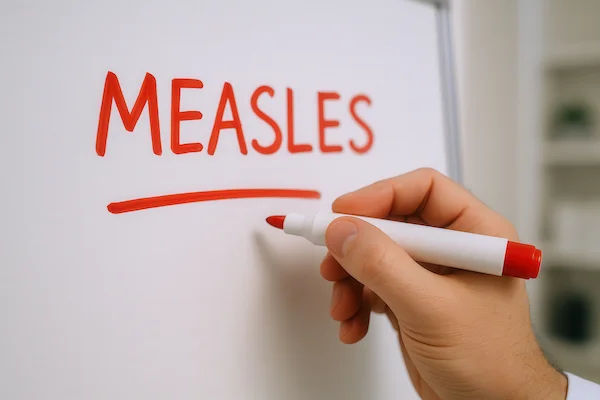- Female
- 25 Years
- 07/02/2025
I've been dealing with swelling on the left side of my neck for about a month now. My doctor diagnosed it as lymph node tuberculosis and gave me some medication to treat it. I've been following the treatment plan for 25 days, but the swelling seems to have increased rather than decreased. Why would it get bigger while I'm on medication? Could it be spreading to other parts of my body?
Answered by 1 Apollo Doctors
yes it can be transfered to other body parts. continue medicines
Dr. Anshul Suggests...
Consult a Infectious Disease specialist
Answered 04/07/2025
0
0

More Infectious Disease Health Queries
View allI'm getting a bit worried because a couple of months back, a street dog tried to bite me but didn't really get a good grip. It left a small wound on my thigh just with one of its teeth, and I cleaned it up with Dettol right afterward. It's been over two months now, and its almost healed there's just a little dark spot left. Everything seemed fine, but now Im starting to get anxious about whether I could've picked up any infections or viruses from it. I see the same dog around regularly, so I can identify it if that helps. What should I do to check if Im all clear from any infections or viruses from the encounter?
Fever Persisting Despite Treatment _Test results interpretation:_ 1. _Initial tests (2132016)_: - Typhoid rapid test: Positive (IgM antibodies), indicating recent typhoid infection. - Negative results for malaria and microfilariae. 2. _Follow-up tests (2552016)_: - Typhoid rapid test: Negative (IgM and IgG antibodies), suggesting the infection has been cleared. _Persisting fever:_ 1. _Possible causes_: - Relapse or re-infection with typhoid - Other underlying infections (e.g., urinary tract infection, pneumonia) - Inflammatory or autoimmune conditions - Medication side effects 2. _Additional tests recommended_: - Blood cultures to rule out ongoing bacterial infections - Complete Blood Count (CBC) to assess for signs of infection or inflammation - Erythrocyte Sedimentation Rate (ESR) or C-Reactive Protein (CRP) to evaluate for inflammatory conditions - Urine analysis and culture to rule out urinary tract infections 3. _Fever type:_ - The persistent fever could be a low-grade fever, which is a common symptom of various conditions.
Answered by 1 Apollo Doctors
My mom had a cannula in her hand for 5 days and it's been about 2 days since it was taken out. She's really in a lot of pain where it was, and now that areas swollen and turned a blue-pink color. She says it feels like there's a throbbing or pulsating pain, almost like there's pus underneath, but we cant see anything. Any idea what might be going on?
Uterine fibroids can be managed without surgery, but a complete cure is often challenging. Medications can help alleviate symptoms, shrink fibroids, and improve quality of life. *Medication Options* 1. *Hormonal therapies*: Gonadotropin-releasing hormone (GnRH) agonists, birth control pills, or progesterone can help reduce fibroid size and symptoms. 2. *Ulipristal acetate*: A medication that can shrink fibroids and reduce bleeding. 3. *Tranexamic acid*: A medication that can help reduce heavy bleeding. 4. *Non-steroidal anti-inflammatory drugs (NSAIDs)*: Pain relievers like ibuprofen or naproxen can help manage pain and cramping. *Other Non-Surgical Options* 1. *Uterine artery embolization (UAE)*: A minimally invasive procedure that blocks blood flow to the fibroids, causing them to shrink. 2. *Magnetic resonance-guided focused ultrasound surgery (MRgFUS)*: A non-invasive procedure that uses ultrasound waves to heat and shrink fibroids. 3. *High-intensity focused ultrasound (HIFU)*: A non-invasive procedure that uses ultrasound waves to heat and shrink fibroids. *Considerations* 1. *Fibroid size and location*: Larger fibroids or those located near the uterine cavity may be more challenging to treat without surgery. 2. *Symptom severity*: If symptoms are severe, surgery might be necessary. 3. *Age and fertility*: If you're trying to conceive, some treatments might not be suitable. *Next Steps* 1. *Consult your gynecologist*: Discuss your treatment options and determine the best course of action for your specific situation. 2. *Monitor fibroid growth*: Regularly track the size and growth of your fibroids to adjust treatment plans as needed. While medications and non-surgical options can help manage uterine fibroids, it's essential to work closely with your healthcare provider to determine the most effective treatment plan for your individual situation.
Answered by 1 Apollo Doctors
I'm really worried because my lab report came back with something called Salmonella typhi H 140. I went to the hospital this morning, and now I'm feeling anxious about what to do next. Can you explain what this means and how I can recover from it?
Salmonella typhi infection is commonly treated with antibiotics. In this case, you can take antibiotics such as Ciprofloxacin or Azithromycin to help recover from Salmonella typhi infection. It is important to complete the full course of antibiotics as prescribed by your healthcare provider. Additionally, make sure to stay hydrated and get plenty of rest to help your body recover.
Answered by 1 Apollo Doctors
Disclaimer: Answers on Apollo 247 are not intended to replace your doctor advice. Always seek help of a professional doctor in case of an medical emergency or ailment.

.webp)



